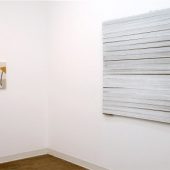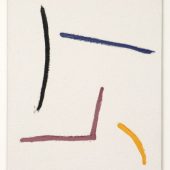Paul Cowan + Matt Stolle
07.18 — 08.15.10
Causality is the relationship between an event (the cause) and a second event (the effect), where the second event is a consequence of the first. Traditionally, we have experienced this relationship with assumed expectations and relations. Aristotle’s example of essential causality is a builder building a house. This single event can be analyzed into the builder building (cause) and the house being built (effect).
Continuing their reflection and analysis of modernity in art, Paul Cowan and Matt Stolle question, analyze, confirm and modify tropes and conventional tactics of the art object and artistic practice. Through their explicit references to the history of painting and modernism, the works here exemplify understanding while analyzing the rhetorical nature of art. Through experience we understand how to experience, possibly gaining an ability to control experience, and potentially losing a variable of perspectives on the experience.
In Causality Without Cause, Cowan and Stolle reconsider the general relations of cause and effect, realizing their roles to be more subjective in the cognitive experience. Through an attempted singularity and isolation of ‘effect’, they search for the origin or ‘cause’ of the work. Within this reassociation, the result is a kind of reversed order; effect and cause. The work certainly celebrates its aesthetic successes (potential effects), threatening acute perception to a point of obtuse and alternate thought. Through this we are left with an analysis of cognition in general.




